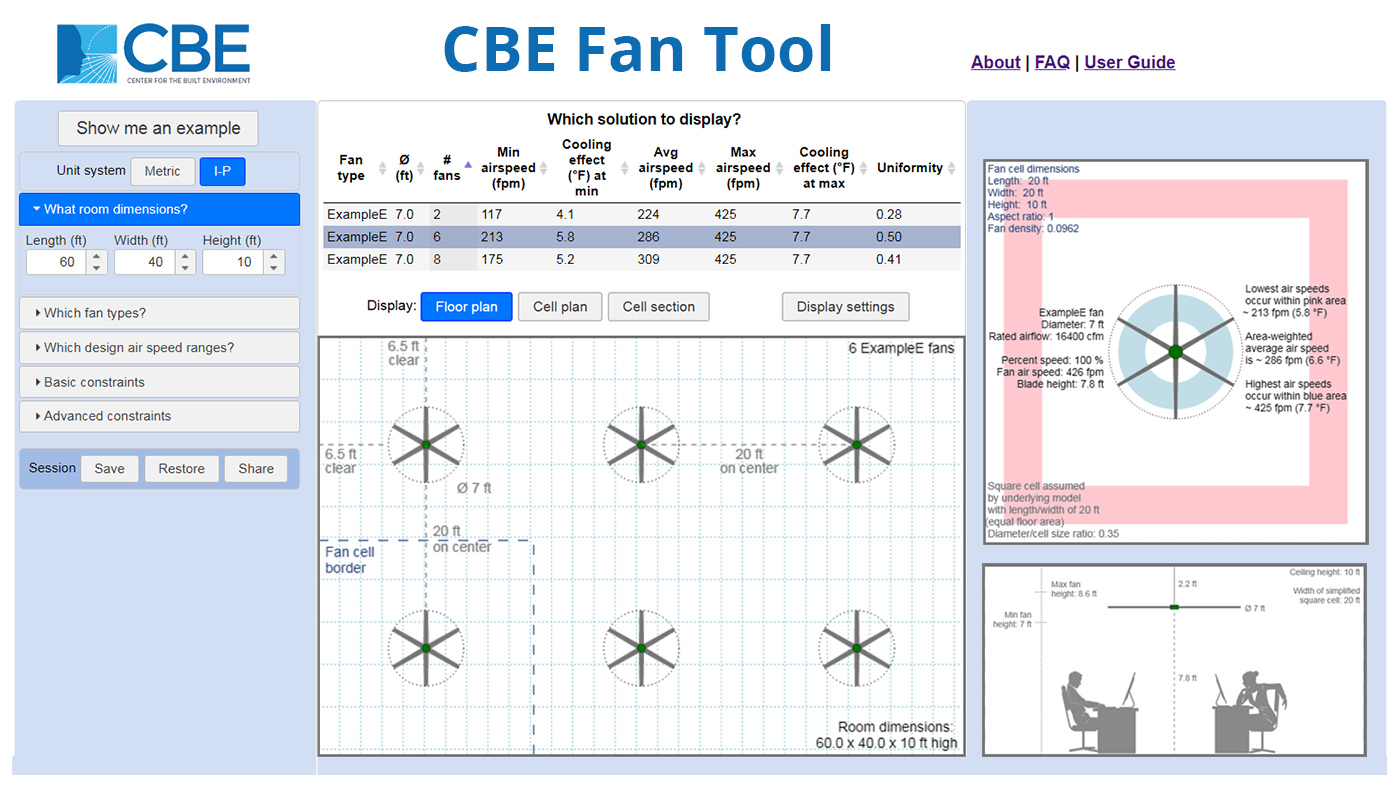Facilitating appropriate specification and layout of fans based on key design parameters.
Status: Completed
Funding Sources: California Energy Commision EPIC Program In-kind Support from Big Ass Fans and CBE Industry Partners
Project Objective
Create a freely available interactive tool that allows designers to quickly select and layout ceiling fans in a room to meet their desired airspeed requirements, and to facilitate incorporation of fans into designs.
Significance to Industry
Having the ability to increase the air speed with fans provides several complimentary benefits in terms of energy efficiency, occupant comfort and perceived air quality. Laboratory studies conducted by CBE and others show that increased air movement provides comfort in warm conditions as high as 86°F (30°C) and with 80 percent relative humidity. Also, a field study found that by adding ceiling fans to an air-conditioned office, subjects were equally or more comfortable at 79-81°F (26-27°C) with increased air movement than they were at 73°F (23°C) without fans, with no change in perceived productivity, concentration or alertness. By adopting higher air temperatures during warm seasons, building operators may reduce HVAC energy use by approximately 5-7 percent per degree Fahrenheit (7-10 percent per degree Celsius) of temperature increase.
Additional benefits from ceiling fans include better perceived air quality, allowing occupants to quickly change their environment (for example providing a direct and immediate cooling effect when desired, much faster than can be achieved using the room thermostat), and destratification of temperatures in cases when this may be problematic. Finally, results from over 35,000 occupant surveys contained in the ASHRAE Global Thermal Comfort Database show that occupants prefer more air movement than they are currently experiencing in buildings.
Research Approach
The development of this tool was based on detailed measurements of air speed profiles generated by ceiling fans in 78 full-scale laboratory tests at Big Ass Fan’s testing facility. This test data was used to create dimensionless models to estimate air speeds for a given combination of fan and room. These tests and the tool development represent a key parts of a multi-year, multi-part study with an overarching goal of creating understanding and insight regarding the energy use patterns and customer acceptance for an integrated solution for smart ceiling fans and learning thermostats. The models from the lab testing were combined with existing best practice knowledge and guidelines into the CBE Fan Tool. This includes incorporating typical code requirements and safety constraints.
The tool has been developed with input from CBE Industry Partners at several membership events. The current design displays a collapsed, blank set of user input fields. As options are completed by users, a various fan options are provided, and subsequent selections are then used by the tool to generate a plan view of the overall space, a ‘cell’ view with fan details, and a section. The layouts displayed are based on the minimum, area-weighted average, and maximum airspeeds in the room using the equations experimentally derived in the laboratory study noted above. The tool is designed to show layouts that produce relatively uniform air velocities throughout a space, however, in some cases it may be preferable not to use a uniform layout, in order to coordinate with lighting, structural, aesthetic, or other requirements of the space.
Publications and Reports
Raftery, P., and D. Douglass-Jaimes. 2020. Ceiling Fan Design Guide. CBE Report. March. https://escholarship.org/uc/item/6s44510d
Raftery, P., J. Fizer, W. Chen, Y. He, H. Zhang, E. Arens, S. Schiavon, and G. Paliaga. 2019. Ceiling fans: Predicting indoor air speeds based on full laboratory measurements. Building and
Environment 155, 210-223. May. https://doi.org/10.1016/j.buildenv.2019.03.040 https://escholarship.org/uc/item/4p479663

